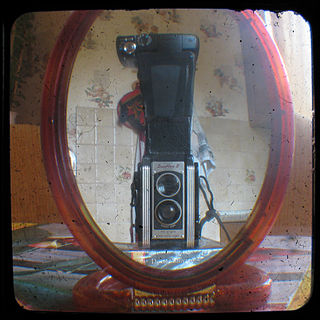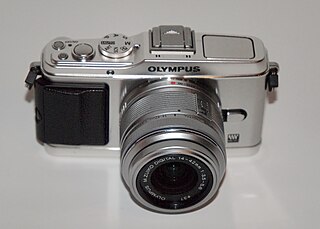
A camera is an instrument used to capture and store images and videos, either digitally via an electronic image sensor, or chemically via a light-sensitive material such as photographic film. As a pivotal technology in the fields of photography and videography, cameras have played a significant role in the progression of visual arts, media, entertainment, surveillance, and scientific research. The invention of the camera dates back to the 19th century and has since evolved with advancements in technology, leading to a vast array of types and models in the 21st century.

A digital camera, also called a digicam, is a camera that captures photographs in digital memory. Most cameras produced today are digital, largely replacing those that capture images on photographic film. Digital cameras are now widely incorporated into mobile devices like smartphones with the same or more capabilities and features of dedicated cameras. High-end, high-definition dedicated cameras are still commonly used by professionals and those who desire to take higher-quality photographs.

A rangefinder camera is a camera fitted with a rangefinder, typically a split-image rangefinder: a range-finding focusing mechanism allowing the photographer to measure the subject distance and take photographs that are in sharp focus.

In photography, a viewfinder is a small window the photographer looks through to see what a photo will look like before they capture it.

A digital single-lens reflex camera is a digital camera that combines the optics and mechanisms of a single-lens reflex camera with a solid-state image sensor and digitally records the images from the sensor.
Video assist is a system used in filmmaking that allows filmmakers to view and distribute a video version of a take immediately after it is filmed. On set, the location where the assist is reviewed is called a video village.

Image stabilization (IS) is a family of techniques that reduce blurring associated with the motion of a camera or other imaging device during exposure.

Live preview is a feature that allows a digital camera's display screen to be used as a viewfinder. This provides a means of previewing framing and other exposure before taking the photograph. In most such cameras, the preview is generated by means of continuously and directly projecting the image formed by the lens onto the main image sensor. This in turn feeds the electronic screen with the live preview image. The electronic screen can be either a liquid crystal display (LCD) or an electronic viewfinder (EVF).
A director's viewfinder or director's finder is a viewfinder used by film directors and cinematographers to set the framing of a motion picture or movie camera. There are three types of director's viewfinders.

The Micro Four Thirds system is a standard released by Olympus and Panasonic in 2008, for the design and development of mirrorless interchangeable lens digital cameras, camcorders and lenses. Camera bodies are available from Blackmagic, DJI, JVC, Kodak, Olympus, Panasonic, Sharp, and Xiaomi. MFT lenses are produced by Cosina Voigtländer, Kowa, Kodak, Mitakon, Olympus, Panasonic, Samyang, Sharp, Sigma, SLR Magic, Tamron, Tokina, TTArtisan, Veydra, Xiaomi, Laowa, Yongnuo, Zonlai, Lensbaby, Venus Optics and 7artisans amongst others.

The α900 (DSLR-A900) is a full-frame digital SLR camera, produced by Sony. An early design study of the camera was shown at PMA on 8 March 2007, and a newer prototype announced at PMA 2008 on 31 January 2008. Sony officially introduced the final camera on 9 September 2008 prior to photokina 2008. In October 2011, Sony Japan announced the camera's end of production.

The Panasonic Lumix DMC-GH1 is a digital mirrorless interchangeable lens camera adhering to the Olympus and Panasonic developed Micro Four Thirds System (MFT) system design standard. Panasonic classified the GH1 as a hybrid stills/video camera and the GH1 was introduced and marketed as a higher end camera than Panasonic's first MFT camera, the stills only, non-video capable Lumix DMC-G1.

The Canon EOS 7D is a high-end APS-C digital single-lens reflex camera made by Canon. It was announced on 1 September 2009 with a suggested retail price of US$1,699, and was marketed as a semi-professional DSLR camera.

A mirrorless camera is a digital camera which, in contrast to DSLRs, does not use a mirror in order to ensure that the image presented to the photographer through the viewfinder is identical to that taken by the camera. They have come to replace DSLRs, which have historically dominated interchangeable lens cameras. Other terms include electronic viewfinder interchangeable lens (EVIL) cameras and compact system cameras (CSCs).

Through the Viewfinder (TtV) photography is a photographic or videographic technique in which a photograph or video or motion picture film is shot with one camera through the viewfinder of a second camera. The viewfinder thus acts as a kind of lens filter. The most popular method involves using a digital camera as the image taking camera and an intact twin-lens reflex camera (TLR) or pseudo-TLR as the "viewfinder" camera. TLRs typically have square waist-level viewfinders, with the viewfinder plane at 90 degrees to the image plane. The image in a TLR viewfinder is laterally reversed, i.e. it is a mirror image. Most photographers use a cardboard tube or other apparatus connecting the two cameras in order to eliminate stray light and prevent reflections from appearing on the viewfinder glass or on the lens of the imaging camera.

The Panasonic Lumix DMC-GH2 is a digital camera with HD video recording capability that is part of the Micro Four Thirds system. Though commonly referred to as a DSLR camera, it has no mirror or optical viewfinder, but has instead both a fold-out LCD screen and a electronic viewfinder.

The Panasonic Lumix DMC-G2 is a digital mirrorless interchangeable lens camera that adheres to the Micro Four Thirds System (MFT) design standard developed by Olympus and Panasonic. It was announced by Panasonic in March 2010 along with the Lumix DMC-G10. The G2 was introduced as the successor to the Lumix DMC-G1 camera, with upgrades such as 720p high-definition video recording capability in AVCHD Lite and Motion JPEG formats.

The Olympus PEN E-P3 announced on 30 June 2011 is Olympus Corporation's seventh camera that adheres to the Micro Four Thirds (MFT) system design standard. The E-P3 succeeds the Olympus PEN E-P2, and was announced in concert with two other models, the Olympus PEN E-PL3, and the Olympus PEN E-PM1.

The Canon EOS 7D Mark II is a professional digital single-lens reflex camera made by Canon. It was announced on September 15, 2014 with a suggested retail price of US$1,799. It features a 20.2 effective megapixel APS-C CMOS sensor, Full HD video recording at 60 fps, 10.0 frames per second continuous shooting, a 100% accuracy viewfinder that offers 1× magnification. It also features a 65-point auto-focus system, a built-in Speedlite transmitter and a new 150k RGB pixels + IR metering sensor. It was preceded by the Canon EOS 7D.

The Canon EOS R is the first full-frame mirrorless interchangeable-lens camera (MILC) produced by Canon. It was announced days after Nikon's first full-frame MILC, the Nikon Z 7, and five years after Sony's first, and was released in October 2018. The camera is the first of Canon's new EOS R system, and the first to use the RF lens mount. The "R" stands for "Reimagine optical excellence".

















